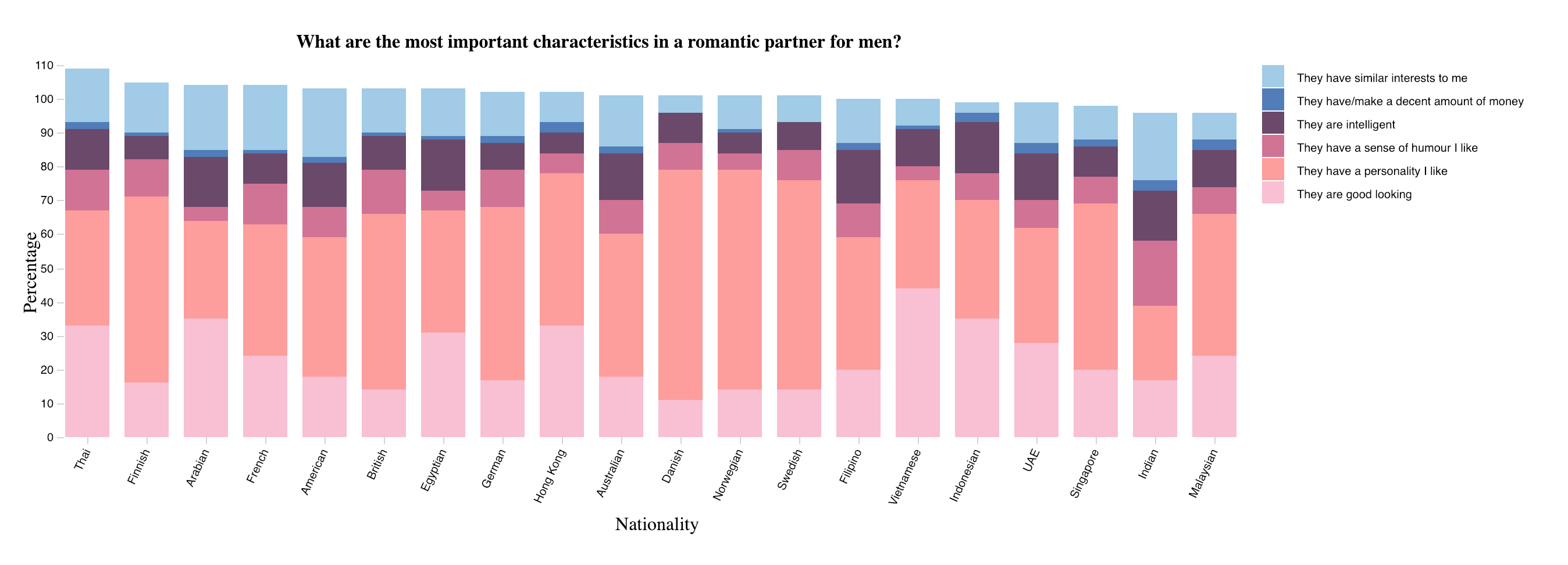Which attributes do people value the most in romantic partners?
By Allison Chan

By Allison Chan

In the age of Instagram and various dating apps that are designed to stress the importance of our looks for success in our social and romantic lives, it is hard to believe that other areas of our identities are as valuable to us as they were before. More than ever, attractive physical appearances are used as a commodity in our visually-driven society.
Across the world, individuals are inclined towards specific attributes that their partner has based on what they value when looking for love. An international study done in 2017 by YouGov of people in 20 countries analyzed these traits and their relative importance to each other.
Surprisingly, they found that personality was the most prioritized above other attributes, including physical appearance.
Firstly, to examine the differences in how people valued each attribute, each scatter plot graph embodies one attribute and shows the percentage of people in each country that ranked it as most important. The second to sixth rankings of the attributes were omitted in these graphs to emphasize only the most important attributes. A scatter plot graph was chosen to represent this information to clearly show the discrepancies between the two dimensions of the data (women and men).
Looking more closely at the data of the personality graph, we are able to see that women prioritize personality more than men. The discrepancy between women and men are most obvious in Egypt, where 17% more women than men ranked personality as the most important. The highest percentage of people who ranked personality as first are Swedish women, at 73% of them who were surveyed. The lowest percentage of people who ranked personality as first are Indian men, at 22% of them who were surveyed. By showing multiple scatter plot graphs, we are able to conclude that personality was generally the most highly valued attribute of women and men in all 20 countries.
Secondly, to examine the differences in all attributes between the two genders, each stacked bar graph represents one of the genders. This helps to emphasize the differences in the preferences of a romantic partner between women and men. The individual bars in each graph represent a different nationality, while the coloured sections of the bars represent one attribute and the percentage of people that ranked it as first. A stacked bar graph was chosen to efficiently represent data that adds up to a total of all the preferences in each nationality combined. Compared to the scatter plot graph, it shows the quantity of how important each attribute is and the discrepancies between the attributes rather than just the discrepancies alone. An interactive hover element over each section of the bars shows more information with the percentage of those who ranked the attribute first.


Looking more closely at the data between the two genders, the graphs are able to emphasize that men prioritize looks more than women. They also show that Vietnamese men are the demographic that prioritizes looks the most in both genders across the 20 countries, with 44% of Vietnamese men surveyed ranking it as most important. Even though it is the lowest prioritized, it is important to note that the graphs show women prioritizing their romantic partners to have/make a decent amount of money slightly more than men. However, no Swedish and Danish women and men ranked having or making a decent amount of money as most important.
Do we see attaining romantic partners as a social norm that we must abide by, do we see them as our teammate in financial stability, or someone that will be a source of our happiness? The data shown in the results of the YouGov survey are an effect of preferences in cultures that emerge from specific geographical, economical, political, and social factors. Therefore, examining the attributes that each nationality values the most can reveal the needs of those living in that country. Perhaps individuals from a heavily capitalist country may value money as an attribute more than other nations, or those from a country that values youth and external appearances may prioritize finding a good looking partner.
By making it implicit that many people value personality over looks, this dataset could potentially change the social perceptions of the audience it reaches. This could be beneficial for individuals that struggle with self-confidence in terms of their physical appearance. However, this is not saying that individuals should ever change themselves to fit the ideal attributes of their romantic partners. In addition, this information could also be sold to companies that may use this data to generate ads and other content based on the preferences of those surveyed. The trajectory of dating apps could also change drastically and lead to more success for users from utilizing these datasets.
Although this data gives us insight to what people value across the world, it is still important to be aware of the limiting factors that contribute to the accuracy of this information. The data was collected from surveys online, and not every country surveyed has a large population of online users. The dataset is also selective with their participants, where there are only two genders and the information about their sexualities are unknown. It is also not implicitly stated in the dataset that all individuals are heterosexual. This informational gap is an area that could be explored for further insights on this topic that may differ greatly from the current dataset.